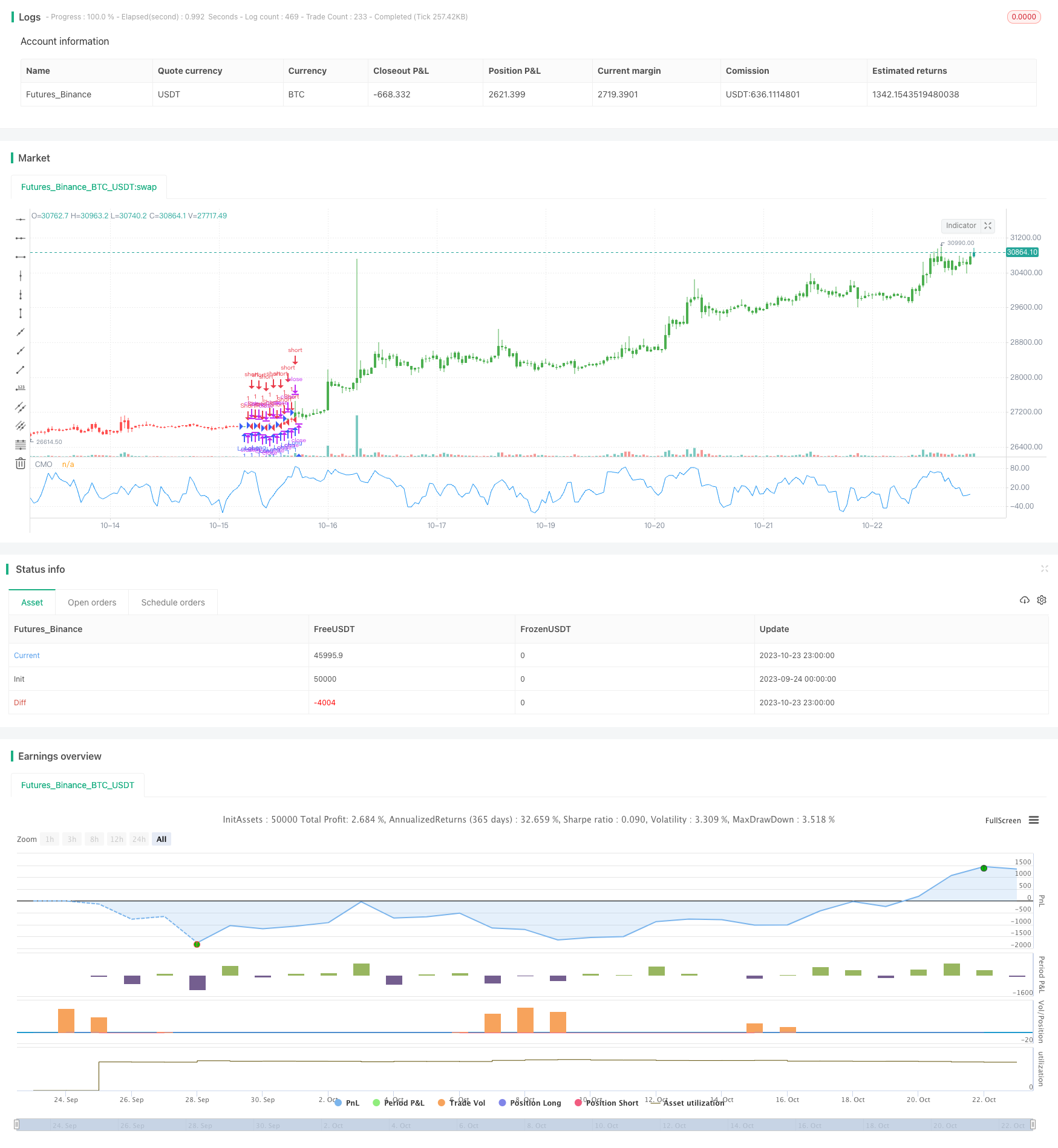
一、策略名称
根据该策略的主要特征,我将其命名为“动量套利策略”。
二、策略概述
该策略通过计算Chande 动量震荡指标,并设定上下阈值构建多空信号,形成套利机会,实现获利。
三、策略原理
代码首先设置参数Length、TopBand、LowBand,Length代表计算动量的天数周期,TopBand和LowBand代表设置的上下阈值。
然后计算最近Length天的绝对动量xMom,再计算xMom的Length日简单移动平均xSMA_mom。
随后计算Length天内的累计动量xMomLength。
接着计算动量震荡指标nRes,等于xMomLength除以xSMA_mom再乘以Length,放大100倍。
根据nRes与上下阈值的大小关系判断多空方向,存入pos。
最后根据是否启用反向交易修正pos,生成交易信号possig,产生多空entries。
四、策略优势
- 使用动量指标识别趋势潜在转折点,利于捕捉趋势
- 结合阈值过滤形成明确的多空信号,避免错误交易
- 应用反向交易思路,能够获取反转机会
- 参数可调节空间大,可以针对不同品种、周期进行优化
- 可视化参数直观,便于掌握交易逻辑
五、策略风险
- 仅考虑动量因素,可能错过其他技术指标形成的交易机会
- 动量突破不一定代表趋势转折,存在误判风险
- 反向交易虽有获利空间,但亦可能加剧亏损
- 参数优化不当可能导致过于频繁交易或错过最佳点位
- 需适当过滤突发事件导致的短期动量失真情况
可通过结合趋势、波动率等其他技术指标来确定动量信号的可靠性,调整参数降低交易频率,适当宽松止损点位等方式来控制风险。
六、策略优化方向
1.加入其他技术指标过滤,提高交易信号准确率
可以在动量信号触发前,判断收盘价是否处于均线系统之上,或波动率是否处于正常范围内,避免被误导。
2.根据品种特性优化参数
对于波动率较高的品种可以适当拉宽动量波动的正常阈值范围,降低交易频率。
3.根据不同时间周期进行多时间框架优化
在日内可以采用较小周期Length,做超短线交易;按照周线或月线来调整参数,侧重中长线趋势。
4.设置底背离条件
在看涨信号触发时,需加上价格高于之前波谷的条件,避免趋势反转的假信号。
七、总结
该策略主要通过动量指标识别短期趋势反转机会,结合参数过滤生成交易信号,兼顾趋势跟踪和反转捕捉,风险可控。通过多 timeframe 优化及组合其他技术指标,可以提升策略交易效果,值得进一步研究与应用。
策略源码
/*backtest
start: 2023-09-24 00:00:00
end: 2023-10-24 00:00:00
period: 1h
basePeriod: 15m
exchanges: [{"eid":"Futures_Binance","currency":"BTC_USDT"}]
*/
//@version=2
////////////////////////////////////////////////////////////
// Copyright by HPotter v1.0 07/02/2017
// This indicator plots Chande Momentum Oscillator. This indicator was
// developed by Tushar Chande. A scientist, an inventor, and a respected
// trading system developer, Mr. Chande developed the CMO to capture what
// he calls "pure momentum". For more definitive information on the CMO and
// other indicators we recommend the book The New Technical Trader by Tushar
// Chande and Stanley Kroll.
// The CMO is closely related to, yet unique from, other momentum oriented
// indicators such as Relative Strength Index, Stochastic, Rate-of-Change,
// etc. It is most closely related to Welles Wilder`s RSI, yet it differs
// in several ways:
// - It uses data for both up days and down days in the numerator, thereby
// directly measuring momentum;
// - The calculations are applied on unsmoothed data. Therefore, short-term
// extreme movements in price are not hidden. Once calculated, smoothing
// can be applied to the CMO, if desired;
// - The scale is bounded between +100 and -100, thereby allowing you to
// clearly see changes in net momentum using the 0 level. The bounded scale
// also allows you to conveniently compare values across different securities.
////////////////////////////////////////////////////////////
strategy(title="CMO (Chande Momentum Oscillator)", shorttitle="CMO")
Length = input(9, minval=1)
TopBand = input(70, minval=1)
LowBand = input(-70, maxval=-1)
reverse = input(false, title="Trade reverse")
// hline(0, color=gray, linestyle=dashed)
// hline(TopBand, color=red, linestyle=line)
// hline(LowBand, color=green, linestyle=line)
xMom = abs(close - close[1])
xSMA_mom = sma(xMom, Length)
xMomLength = close - close[Length]
nRes = 100 * (xMomLength / (xSMA_mom * Length))
pos = iff(nRes > TopBand, 1,
iff(nRes <= LowBand, -1, nz(pos[1], 0)))
possig = iff(reverse and pos == 1, -1,
iff(reverse and pos == -1, 1, pos))
if (possig == 1)
strategy.entry("Long", strategy.long)
if (possig == -1)
strategy.entry("Short", strategy.short)
barcolor(possig == -1 ? red: possig == 1 ? green : blue)
plot(nRes, color=blue, title="CMO")